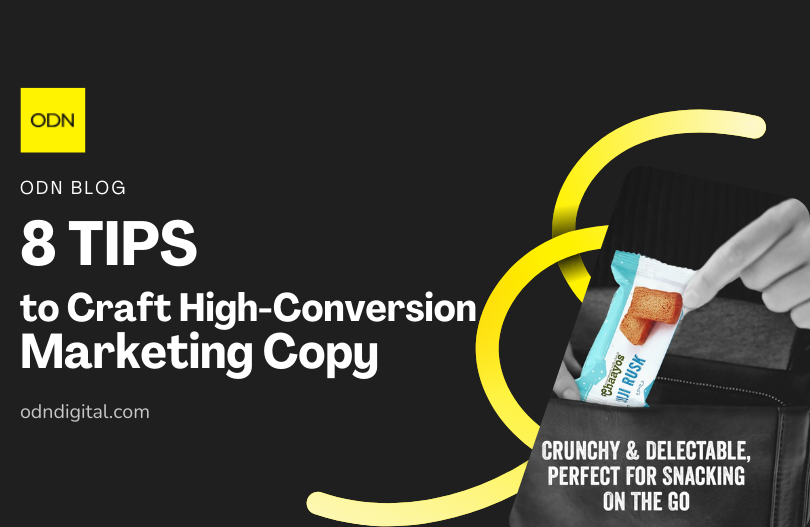
8 Tips to Craft High Conversion Marketing Copy
E-commerce marketing copy is so much more than stringing words together to describe a product. To drive conversions and cultivate lasting customer relationships, every phrase and sentence must be strategically crafted to speak to shoppers and compellingly position your brand.
Follow these tips to transform product descriptions, website content, and other marketing copy from generic to high-converting.
- Define Your Unique Brand Voice
Consistent branding is key for e-commerce businesses. Before drafting any marketing copy, establish your brand’s persona and voice. Figure out how you want to interact with customers across channels. Should your tone be friendly and earnest? Knowledgeable and authoritative? Witty with a touch of humor?
Analyze how competitors communicate their brand voices through their marketing copy. Then brainstorm words that authentically encapsulate your company’s personality. Is your voice stylish? Reliable? Empowering? Whatever adjectives you land on, ensure they guide every customer interaction through copy.
- Truly Understand Your Target Audience
The foundation of marketing copy is an in-depth understanding of who you are speaking to. Go beyond basic demographics to paint a detailed picture of your ideal buyer personas through market research. Analyze your existing customer base and traffic analytics to identify shared psychographics. What motivates them? What challenges do they face? How do they consume content?
With detailed personas in mind, you can tailor every phrase to align with customer values, pain points and lifestyle. Marketing copy that directly speaks to their needs will always convert better than generic descriptions. Relatable messaging feels like a personalized experience.
- Flawlessly Work Keywords Into your Marketing Copy
Keyword optimization is non-negotiable for e-commerce SEO. But don’t just cram every hot keyword into copy arbitrarily. Research which search terms customers are using to find your products and organically incorporate the most valuable ones across your site and product copy.
Prioritize keywords with high traffic and low difficulty for the best ROI. Spin different keyword variations into natural sentences in product titles, descriptions, image alt text, site content, and more. This amplification cements relevancy in search engines’ algorithms, increasing click-through rates.
- Lead With Benefits and Solutions
Don’t simply regurgitate product features in descriptions. Zero in on each feature’s direct benefit to the customer’s lifestyle or pain point. Shoppers invest in solutions, not specs. Reframe details as benefits whenever possible. For example, convert “moisture wicking fabric” to “stays dry and comfortable during workouts”.
You can take this a step further by addressing the actual problem being solved too. “No more chafing thighs during marathon training runs” powerfully reframes the benefit. When marketing copy focuses on relieving customer challenges, products sell themselves.
- Share Your Brand Story Sincerely
Today’s consumers value transparency from companies they support. Use marketing copy as a chance to share your origin story and core values. Was your business founded to fill a need or gap in the market? Does your team have relevant expertise and lived experiences? Are you on a mission to give back?
Authentic stories about how your product or service came to life, why it exists, and what sets it apart build an emotional connection. Help customers know, like, and trust your brand by opening up through sincere marketing copy.
- Strategically Add Urgency With Scarcity
Reminding shoppers of limited-time offers and availability pressures them to purchase promptly, which benefits conversion rates. But avoid overly aggressive scare tactics. Time-sensitive promotions should incentivize customers organically.
Rather than threatening stock running out arbitrarily, reference real metrics like only having X units of a top-selling item left in inventory. The specificity sounds authentic. Urgency can also come from highlighting sales ending soon or special discounts on seasonal items before they’re discontinued.
- Write How Customers Speak
Adopt a conversational yet polished tone in copy. While professionalism is still expected, an extremely formal or stiff copy can feel sterile and robotic. Modern customers engage more with natural, friendly language using contractions, personal pronouns, and simple sentence structures.
Of course, colloquialisms and slang should be avoided. Find a balance between relaxed and refined by reading the copy out loud. Does it sound like an everyday chat? Tweak any passages that seem too stiff.
- Maintain Consistent Brand Messaging
Once you find copywriting that converts, stick with it. Analyze top-performing product descriptions and website content to identify key phrases, themes, and messaging that resonate. Standardize this vocabulary across your catalog to reinforce messaging through repetition.
Consistency establishes credibility and familiarity. Shoppers remember unique brands that sound the same every time. Whether writing new copy or updating existing, always align with proven messaging that works.
Conclusion
E-commerce marketing copy is equal parts art and science. You need creativity to craft narratives that resonate paired with analytical skills to reinforce strategies through repetition. But first and foremost, stellar copy clarifies why your brand alone can solve customers’ needs. Tell that story compellingly across every touchpoint.






Leave a comment